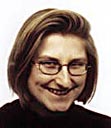Jan VALENTA
Institute of Physics, Prague
valenta@fzu.cz

Silvia VENTURA
Laboratori Nazionali di Frascati
silvia.ventura@roma2.infn.it

For my Diploma thesis I've worked for the KLOE collaboration I've analysed the phi decay in f0(980)+gamma. For my PhD thesis I'm partecipating to the Atlas experiment at LHC, with the 'Laboratori Nazionali di Frascati' group. My research work is dedicated to the study of the physics processes characterized by muons in the final state. The muon signature allows to identify the most interesting channels,as the Higgs decay in four muons state. The optimal selection criteria and identification algorithms are found by detailed simulation studies, that takes into account the actual detector performances, which are studied by beam tests and/or cosmic ray tests.


